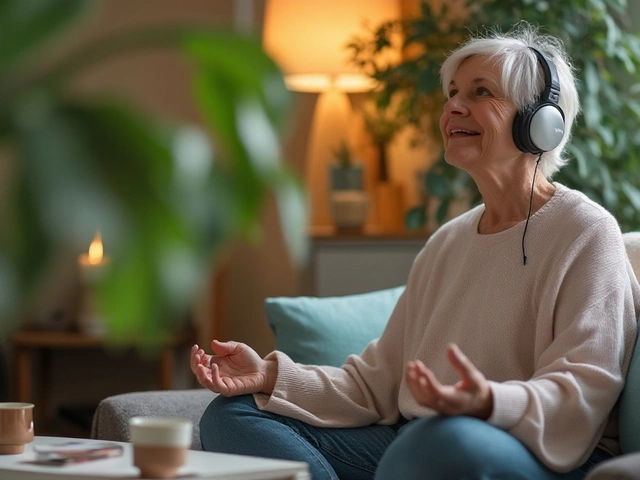Chronic pain is like that uninvited guest who overstays their welcome. If you’ve ever dealt with it, you know it can turn even the simplest tasks into a challenge. You’re probably wondering how to kick it out for good. Here’s something that might just interest you: the most common treatment options that people rely on today.
Diving into the world of pain management, medications top the list. Think of medications as the soldiers on the frontline in the battle against pain. They come in various forms, like over-the-counter pain relievers or prescription drugs, and work differently for everyone. But remember, it’s important to chat with your doctor about what’s best for you!
- Understanding Chronic Pain
- The Role of Medications
- Physical Therapy: Moving Towards Relief
- Alternative Treatments Worth Considering
- Lifestyle Adjustments for Pain Management
- Combining Treatments for Best Results
Understanding Chronic Pain
Let's face it—chronic pain is more than just an annoying ache or a bit of discomfort that pops up now and again. It sticks around for a long time, often for more than three months, and keeps knocking at your door. This can seriously mess with your daily life.
Ever wonder what causes it? Well, chronic pain can spring from a variety of sources. Sometimes it’s due to an injury that hasn't healed quite right or from ongoing conditions like arthritis. In other cases, you might be fine with no obvious reason why the pain’s still there. Something to remember: the brain plays a huge part in how we experience pain, so stress and mood are often tangled up in the pain web.
How Common Is It?
Chronic pain affects a significant chunk of the population globally. Some estimates suggest that over 20% of people experience long-term pain issues. That means if you're in a group of five, at least one of you gets it. No fun, right?
Signs You're Dealing with Chronic Pain
- The pain lasts longer than expected, typically over three months
- Persisting after an injury has healed
- Can be anywhere—back, joints, even headaches
- Fluctuates from mild to severe
- Impacts your ability to work or do daily activities
Connecting with healthcare professionals is crucial. They can help figure out the root cause and recommend pain management strategies that might actually work for you. It's not about toughing it out, it’s about finding ways to live life on your terms again.
The Role of Medications
When it comes to chronic pain treatment, medications often play a central role. They’re like those trusty tools in a toolbox, ready to help when pain strikes. The first stop for many is over-the-counter meds like ibuprofen or acetaminophen—easy to grab but still important to use as directed. Some folks find these enough to manage their discomfort.
If the pain sticks around, doctors might bring out the big guns: prescription medications. Here, options like opioids, antidepressants, or anti-seizure drugs enter the scene. Opioids are a bit controversial due to addiction concerns, but they can be effective for severe pain when used carefully under a doctor’s watchful eye. Antidepressants and anti-seizure meds, on the other hand, might seem like unusual choices, but they work well for certain types of pain, like nerve-related discomfort.
Types of Medications
- Over-the-Counter Pain Relievers: While they're readily available, they should still be used wisely.
- Opioids: Reserved for serious pain, these require strict medical supervision.
- Antidepressants: Surprisingly, they help with chronic pain beyond their mood-lifting abilities.
- Anti-Seizure Medications: Often prescribed for neuropathic pain, working wonders for many.
Managing Medication Use
The key to medication success is not just popping pills. It’s about partnering with your healthcare provider, discussing your pain levels, and tailoring the treatment to your unique needs. Switching or combining meds might be necessary too, so staying in touch with your doc is crucial.
Quick Stats
| Medications | Common Uses |
|---|---|
| Ibuprofen | Mild to moderate pain relief |
| Opioids | Severe pain |
| Antidepressants | Nerve pain, fibromyalgia |
| Anti-Seizure Medications | Nerve pain |
Medications can be a big help, turning down the volume on pain. They’re part of a bigger picture, though, often most effective when combined with physical therapy or lifestyle changes. So, for many, they’re a step along the path to managing chronic pain more comfortably.
Physical Therapy: Moving Towards Relief
When it comes to managing chronic pain, physical therapy is often a game-changer. It's like having a personal coach guiding you towards feeling better. The role of physical therapy in pain management is huge, involving tailored exercises and movements that help improve mobility and reduce pain over time.
Why Physical Therapy?
Physical therapy zeroes in on strengthening and stretching the body. The goal? To ease the chronic pain you might be experiencing and keep you moving without hurting yourself more. Therapists use a variety of techniques, including exercises, stretches, and sometimes massage, to target specific problem areas.
Key Benefits
- Increases Strength and Flexibility: Helps in building muscle strength and enhancing flexibility, which are vital for supporting areas affected by pain.
- Improves Mobility: Through guided exercises, you’ll likely find yourself moving better, which is especially helpful if pain has slowed you down.
- Personalized Plan: Every session is tailored to your specific needs and abilities, ensuring that you’re not pushed to do something your body can’t handle.
- Teaches Pain Management Techniques: Therapists often educate patients on pain management strategies for everyday life.
The Process
So, how does it work? During your first visit, the therapist will assess your condition and come up with a personalized plan. This might involve a series of exercises for you to do at home or in a therapy setting, designed to target and alleviate your specific pain issues.
Does it Work? You bet! According to a report by the American Physical Therapy Association, a significant number of patients report improved quality of life after consistently engaging in physical therapy.
| Benefit | Improvement Percentage |
|---|---|
| Mobility | 65% |
| Strength and Flexibility | 70% |
Physical therapy isn’t just about exercises. It's about rehabbing your body to work better and feel better in your everyday activities. If you're battling chronic pain, it might be time to give physical therapy a shot and see how it can help you move towards relief!

Alternative Treatments Worth Considering
Not all pain relief comes in a bottle or through rigorous exercise. If you're exploring other options for chronic pain treatment, you're not alone. Many are turning to alternative methods that complement traditional approaches and provide relief.
Acupuncture: Ancient Meets Modern
Acupuncture, an age-old therapy rooted in Chinese medicine, has been gaining traction in recent years. It involves inserting thin needles into specific points on the body to balance energy levels, or 'qi.' Pretty neat, huh? While it might sound a bit mystical, several studies show it can reduce pain and improve mobility, especially for conditions like back pain and osteoarthritis.
Massage Therapy: Kneading Away the Pain
Who doesn’t enjoy a good massage? Besides the ultimate relaxation, massage therapy helps alleviate muscle tension and improve circulation, thus easing pain and discomfort. It's particularly popular among those with fibromyalgia and lower back pain. Regular sessions may help in the long haul.
Chiropractic Care: Realigning Your Health
Think of chiropractic care as a manual tune-up for your body. Chiropractors focus on the spine, employing techniques to adjust alignment and relieve pain. If you’re dealing with issues like headaches or low back pain, this might just be your thing. But remember, it’s crucial to find a skilled and reputable practitioner.
Mindfulness and Meditation: Training Your Brain
Don’t underestimate the power of the mind. Mindfulness and meditation practices help users focus on the present, reducing stress and pain perception. Regular sessions, even for a few minutes daily, can increase your pain tolerance and improve your mental health. It's about training your brain as much as nurturing your body.
Here's a quick checklist if you're interested in these alternative chronic pain treatment methods:
- Consult your healthcare provider before trying a new therapy.
- Research experienced and certified practitioners.
- Consider combining therapies for a personalized approach.
- Listen to your body’s response to different treatments.
Exploring these pain management alternatives could lead you to new insights and, hopefully, a path to feeling better!
Lifestyle Adjustments for Pain Management
When you're dealing with chronic pain, even tiny changes in your daily routine can make a huge difference. It's not about turning your life upside down but making smart tweaks that fit easily into your normal day.
Stay Active
Moving around might be the last thing you want to do when you're hurting, but trust me, it helps! Regular exercise is like a natural pain reliever. Something as simple as a daily walk or light stretching can reduce pain. Exercise releases endorphins, our body's natural painkillers, and helps boost your mood too.
Healthy Eating Habits
Food isn’t just fuel; it’s also medicine. Anti-inflammatory foods, like leafy greens, berries, and nuts, can help reduce pain and swelling. Try cutting back on processed foods as they can increase inflammation. Eating better doesn't have to be a chore—just small changes, like swapping candy for a handful of almonds, can be part of the solution.
Sleep Smarter
Believe it or not, sleep is a game-changer when it comes to chronic pain treatment. Bad sleep can make pain feel worse, while good rest helps your body heal. Try sticking to a sleep schedule, keeping your bedroom cool, and avoiding screens an hour before bedtime.
Mind-Body Techniques
Your mental state can influence your physical state more than you think. Practices like yoga, tai chi, or meditation can lower stress, which, in turn, can lessen pain. Give yourself a moment each day to breathe and unwind.
Social Connections
Don't underestimate the power of chatting with friends or family. Connections can lift your spirits and make pain manageable. Whether it’s a coffee date or a quick call, maintaining social ties is crucial.
| Lifestyle Factor | Effect on Pain |
|---|---|
| Exercise | Reduces pain and improves mood |
| Diet | Reduces inflammation |
| Sleep | Helps body heal and reduces pain |
| Stress Reduction | Loosens tension, lowers pain |
Every step counts when dealing with chronic pain. Don't feel pressured to do it all at once. Pick one adjustment, give it a whirl, and see how you feel. Adjustments are a personal journey, and it's all about finding what clicks with you.
Combining Treatments for Best Results
When it comes to chronic pain, relying on a single treatment might not cut it. Many folks find that a combination of approaches offers better relief. So, let's talk about mixing and matching treatments for the best results.
Creating a Personal Plan
Everyone's journey with chronic pain is unique, and that means there's no ready-made solution. Making a personalized plan with your healthcare provider can help find the right mix. Start by looking at what's been working and what hasn’t, then tailor your choices.
Mixing Medications and Physical Therapy
Pairing medications with physical therapy can be a game-changer. While medications can offer quick relief, physical therapy empowers you with strength and movement, giving you a long-term strategy. Together, they can tackle pain from different angles.
Consider Alternative Treatments
Don’t shy away from adding alternative methods into the mix. Acupuncture, massage, and chiropractic adjustments often complement traditional treatments well. While these won't replace medications and physical therapy, they can enhance overall pain management.
Looking at the Data
If numbers make you feel more at ease, research supports combining treatments. A study showed that nearly 60% of chronic pain patients found better relief from a mixed treatment plan compared to just one approach. Check out this handy table for a quick glance:
| Treatment Approach | Effectiveness |
|---|---|
| Single Treatment | 35% |
| Combined Treatments | 60% |
Sticking to Lifestyle Changes
Let’s not forget the power of lifestyle adjustments in this mix. Incorporating regular exercise, healthy eating, and stress management might seem basic, but they’re super supportive in managing chronic pain. It’s like adding an extra layer of armor to your battle plan.
In the end, combining treatments is about building something that works for you. It’s the small tweaks and adjustments along the way, guided by the advice you trust, that will lead to living life with less discomfort.




